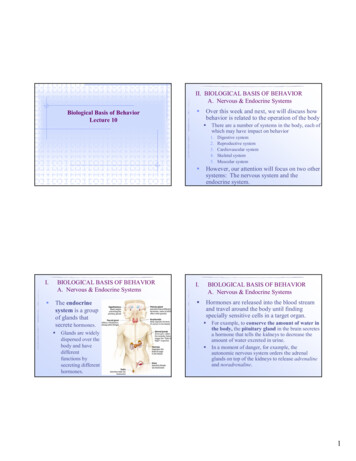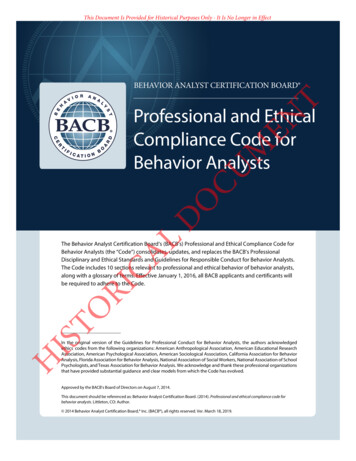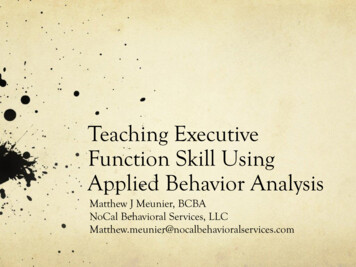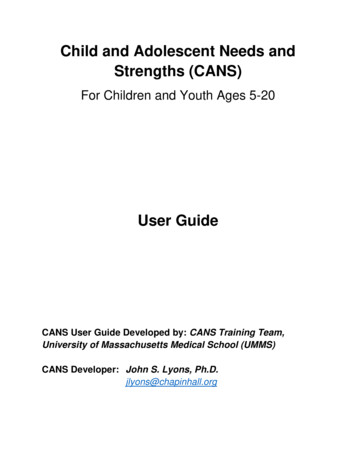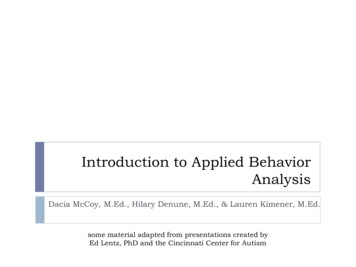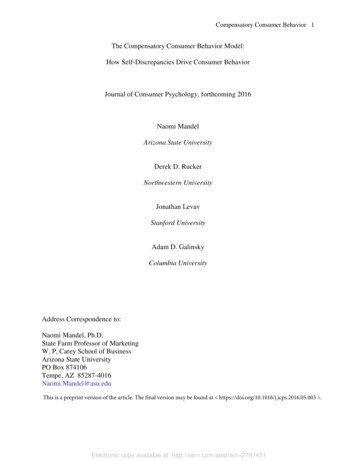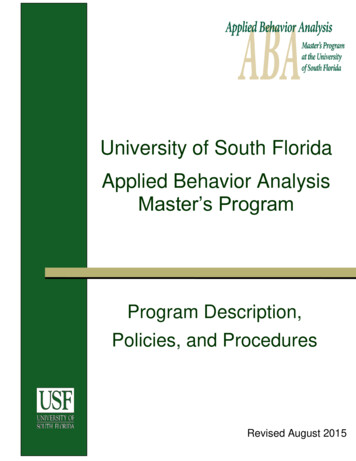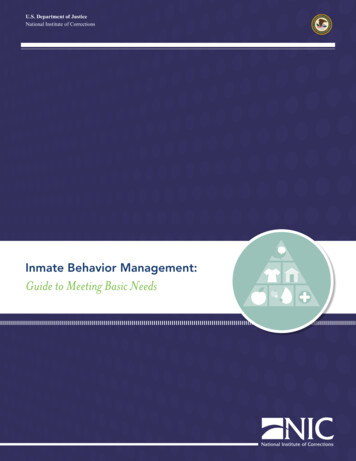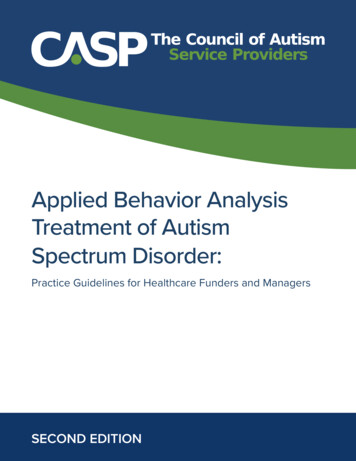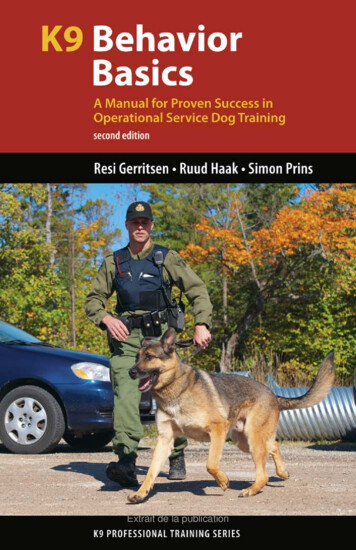
Transcription
Extrait de la publication
K9 BEHAVIOR BASICSExtrait de la publication
Other titles in the K9 Professional Training seriesK9 Search and Rescue, 2nd ed.K9 Schutzhund Training, 2nd ed. (Coming in 2014)Other K9 titles from Brush EducationAggression ControlDecoys and AggressionK9 Complete CareK9 Explosive DetectionK9 Fraud!K9 Officer’s ManualK9 Personal ProtectionK9 Professional TrackingK9 Scent DetectionK9 Suspect DiscriminationK9 Working BreedsPolice Officer’s Guide to K9 SearchesExtrait de la publication
K9 BEHAVIOR BASICSA Manual for Proven Success inOperational Service Dog TrainingSecond editionDr. Resi GerritsenRuud HaakSimon PrinsK9 Professional Training seriesExtrait de la publication
Copyright 2013 Resi Gerritsen, Ruud Haak and Simon Prins13 14 15 16 17 5 4 3 2 1Excerpts from this publication may be reproduced under licence from Access Copyright,or with the express written permission of Brush Education Inc., or under licence from acollective management organization in your territory. All rights are otherwise reservedand no part of this publication may be reproduced, stored in a retrieval system, or transmitted in any form or by any means, electronic, mechanic, photocopying, digital copying,scanning, recording or otherwise, except as specifically authorized.Brush Education Printed and manufactured in CanadaEbook edition available at Amazon, Kobo, and other e-retailers.Editorial: Lauri Seidlitz, Leslie VermeerCover design: John Luckhurst; Cover photo: Kelly Nelson/ShutterstockBook interior design: Carol Dragich, Dragich DesignIllustrations: Sandra HamelLibrary and Archives Canada Cataloguing in PublicationGerritsen, Resi, author K9 behavior basics: a manual for proven success in operationalservice dog training / Dr. Resi Gerritsen, Ruud Haak and Simon Prins.—Second edition.(K9 professional training)Originally published: Calgary: Detselig Enterprises, 2010. Includes bibliographical references. Issued in print and electronic formats. ISBN 978-1-55059-451-5 (pbk.).1. Service dogs—Behavior. 2. Service dogs—Training. 3. Search dogs—Training.4. Rescue dogs—Training. I. Haak, Ruud, author II. Prins, Simon, 1967-, author III. Title.SF428.2.G473 2013 636.73C2013-903631-8C2013-903632-6Produced with the assistance of the Government of Alberta, Alberta Multimedia Development Fund. We also acknowledge the financial support of the Government of Canadathrough the Canada Book Fund for our publishing activities.Extrait de la publication
ContentsIntroduction . vii1Operational Service Dogs . 12Ancestor Wolf. 273Basic Concepts in Dog Behavior . 434Developmental Stages and Behavior . 655Expressions, Gestures, and Signals . 816Reading Your Dog . 1097Operant Conditioning: Development and BasicPrinciples . 1278Physical Punishment in Dog Training . 1699Training Service Dogs Using Operant Conditioning . 195Bibliography . 233About the Authors . 237Extrait de la publication
This page left intentionally blankExtrait de la publication
IntroductionThe dog has been a loyal companion of humankind for thousandsof years. This companionship has not always meant a comfortableand peaceful life for the dog, however. In living together, humanstook control. From wolves (the first dogs), humans selected animals with suitable traits and domesticated them.Our dogs today have a great willingness to adapt to their circumstances and the rules of the pack, which now includes thehuman family. They are a pleasant animal, able to live close to humans. From the wolf they received qualities such as watchfulness,loyalty, and submissive behavior, which are also the source of theirpopularity as pets and K9s.In this book we meet the wolf, the domestic dog’s ancestor.We become acquainted with its behavior and see how and whythis animal was domesticated. From that foundation, we take acloser look at dog behavior and communication signals. These arefundamental to understanding how dogs play and learn, and it isimportant for every K9 handler to understand these behaviors. After all, if we understand the behavior of dogs, we can more easilyraise and train them.It is a pleasure to have a K9 as a reliable companion in service.For a successful team, the parties at both ends of the leash must
VIIIINTRODUCTIONtrust each other. For this trust to develop, it is essential for us torecognize and correctly interpret the dog’s expressions, gestures,and signals. In this book we explain them.We then explain operant conditioning, a successful method ofK9 training that can be used for all kinds of special-service dogs,such as search and detection, patrol, remote guided camera, andattack dogs. We first describe the history and development of operant conditioning training with animals and how the trainingworks, and then, of course, we provide practical techniques in howthis method can be employed.As a K9 handler, you are privileged to know what is going onin the dog’s mind and to predict its behavior. After reading thisbook, you will have a better understanding of that special animal:your K9.—Resi Gerritsen, Ruud Haak, and Simon PrinsDisclaimerWhile the contents of this book are based on substantial experience and expertise,working with dogs involves inherent risks, especially in dangerous settings and situations. Anyone using approaches described in this book does so entirely at their ownrisk and both the author and publisher disclaim any liability for any injuries or otherdamage that may be sustained.
This page left intentionally blankExtrait de la publication
Figure 1.1 Dogs have served many roles for humans.In this picture, the legendary Barry, a short-haired SaintBernard, saved forty human lives during his work as anavalanche dog at a hospice in the Swiss Alps.Figure 1.2 Roman dog of war.Extrait de la publication
1OperationalService DogsDogs can be found everywhere people live. Through the ages dogshave helped humans as hunters and also as defenders of hearthand home. In some countries, dogs are still used for meat; in thespacious polar snowfields, they give their energy as draft animals;and they provide many other services to humans, from shepherd tolaboratory animal. Some people are sensitive about how dogs areused—performing tests on or eating a dog is unthinkable for manypeople because they consider dogs to be loyal friends, companions,and sometimes even replacements for children.Loyal Friends and CompanionsBy close and long association with humans, both in work and inplay, the dog has become a symbol of loyalty and friendship. Indeed, it is as a companion that the dog is best known. In that workwe find no specialists, no distinctions of color, breed, or training, yet the household pet must, in a sense, work for its living.Put yourself in your dog’s place. Would you enjoy the job of being companion to a person of your own temperament? Could youfancy yourself an unassuming nonentity, keeping out from under1
2K 9 B E H AV I O R B A S I C Sfoot when your owners are glum, being scolded without apparentcause when they are irritable? Would you always be eager to takea walk to satisfy their whim just at the moment when you hadsettled down for a good snooze? And could you endure the caressof unliked, strange hands simply because those hands belong to afriend of your handler? Would it please you to obey every word,look, and gesture—yes, even unexpressed thoughts, regardless ofyour own wishes? It would be hard work at times, wouldn’t it?LORD BYRON AND BOATSWAINFigure 1.3 Boatswain, painted in 1808 by Clifton Tomson.A powerful example of the attachment people can form with their dogs isseen in the relationship between Lord Byron (1788–1824) and his dog, a Newfoundlander called Boatswain. After the death of his dog of rabies in 1808 atNewstead Abbey, the brokenhearted Lord Byron had the dog buried behindthe ruins of the old abbey church near the house. It was a special and solemnfuneral. After the burial, Lord Byron called his eldest servant and told him thatboth he and the servant would be buried next to Boatswain. The servant wasapparently not so pleased because shortly after this instruction, he resignedfrom his job. Lord Byron himself died as a freedom fighter in the war of independence of the Greeks from the Turks, so Boatswain was left all alone at thecountry estate.
O P E R AT I O N A L S E R V I C E D O G S3Over the grave is a large, ornamental memorial. The epitaph reads as follows.Near this Spotare deposited the Remains of onewho possessed Beauty without Vanity,Strength without Insolence,Courage without Ferocity,and all the virtues of Man without his Vices.This praise, which would be unmeaning Flatteryif inscribed over human Ashes,is but a just tribute to the Memory ofBOATSWAIN, a DOG,who was born in Newfoundland May 1803and died at Newstead Nov. 18, 1808.When some proud Son of Man returns to Earth,Unknown by Glory, but upheld by Birth,The sculptor’s art exhausts the pomp of woe,And storied urns record who rests below.When all is done, upon the Tomb is seen,Not what he was, but what he should have been.But the poor Dog, in life the firmest friend,The first to welcome, foremost to defend,Whose honest heart is still his Master’s own,Who labours, fights, lives, breathes for him alone,Unhonoured falls, unnoticed all his worth,Denied in heaven the Soul he held on earth—While man, vain insect! hopes to be forgiven,And claims himself a sole exclusive heaven.Oh man! thou feeble tenant of an hour,Debased by slavery, or corrupt by power—Who knows thee well must quit thee with disgust,Degraded mass of animated dust!Thy love is lust, thy friendship all a cheat,Thy tongue hypocrisy, thy words deceit!By nature vile, ennobled but by name,Each kindred brute might bid thee blush for shame.Ye, who perchance behold this simple urn,Pass on—it honors none you wish to mourn.To mark a friend’s remains these stones arise;I never knew but one—and here he lies.Extrait de la publication
4K 9 B E H AV I O R B A S I C STypes of K9sEarly human communities used the dog’s sense of loyalty andresponsibility for their own ends. Ancient history gives us manyexamples of dogs used as defenders, but also dogs used for othertasks. For example, more than eleven hundred years ago, a Chinesetrading company developed a dog messenger service. These dogswent out with camel caravans and brought back dispatches fromthe outposts. The trading company found that the advance information thus obtained was of such value that it credited ten percentof its increased sales to this service and used the money to breedbetter dogs and otherwise develop the efficiency of the service.A similar service was used in the first half of the twentieth centuryby armies around the world.Figure 1.4 Through the agesdogs have played important rolesfor human societies. This picturefrom an ancient Greek vaseshows the mythologicalCerberus, a dog with (in this case)two heads.Figure 1.5 Hunting with dogs. This stonepanel decorated a mud brick wall of thepalace of King Ashurbanipal (reigned669–630 BCE) at Nineveh, northern Iraq.It was originally part of a much longercomposition related to the royal sportof lion hunting. The figures leading thehounds are hunt attendants. The use ofmastiffs is well represented on the wallreliefs at Nineveh.Extrait de la publication
O P E R AT I O N A L S E R V I C E D O G S5Figure 1.6 Earlyseventeenth-centurywoodcut showing nightwatchmen and dogs.From their earliest domestication, dogs were used as watchdogsto alert human camps about the approach of animals or humans.The Romans extended the watchdog’s activities to include dutywith a human sentry. This sentinel dog of ancient times was insome respects a forerunner of the modern police dog. The cityarchives in Antwerp, Belgium, note that the first night watchman in Antwerp was chartered in 1597, and by 1627 there werethirty-two men on duty. Woodcuts from that time indicate thatprotection dogs accompanied these men. These early policedogs were apt to bite: one woodcut (Figure 1.6) shows a doghelping its handler by boldly biting the legs of a villain!Police Service DogsOne of the oldest known police services using dogs is that of theBelgian city of Leuven (Louvain) in the eighteenth century. In1786, the night watchmen distributed a “New Year’s greeting” flyerto all residents. On it was a woodcut depicting the town soldiersExtrait de la publication
6K 9 B E H AV I O R B A S I C SFigure 1.7 NewYear’s greetings fromthe nightwatchmen.and their dogs. In 1793, however, the use of police dogs in Belgium was abolished. A “human rights” manifesto banned the useof dogs to attack people. It appears that the police dogs had become too sharp and aggressive for public acceptance.After the abolition of police dogs in Belgium, more than a century passed before public administration resumed the use of dogsin police service. Around 1880, dog enthusiasts near Malines, Belgium, began to systematically train their Malinois, the shorthairedBelgian shepherd dog, for protection and tracking work. But it wasnot until 1886 that dogs were specifically trained for police service.At that time, the little hamlet of Hildesheim, Germany, was a hotbed of disorder and a source of embarrassment and chagrin to thefrustrated police. Captain Schoenherr, later head of the PrussianGovernment Breeding and Instruction School of Service Dogsat Grünheide, near Berlin, studied the possibility of using dogsto combat criminals. A few specially trained animals were tested.The dogs performed successfully and problems in Hildesheimwere cleared up, largely through their efforts. The Hildesheim dogs
O P E R AT I O N A L S E R V I C E D O G S7Figure 1.8 During the World War I, Dutch police dogs were alsotrained as liaison or communication dogs.became celebrities, and other German communities were inspiredto use dogs in police service.In Gent, Belgium, Superintendent Van Wezemael introduced three police dogs in March 1899. At the end of the sameyear, there were ten dogs in service, and by 1910 there were morethan thirty. All these dogs were Belgian shepherd dogs, and mostof them were of the Groenendael (black long-haired Belgian shepherd) and Malinois variety. As the dogs proved their usefulness inpolice work, they were trained in special fields of service, and todaythere are many branches of police dog work.POLICE DOGS TODAYToday’s police dog is the natural development of the herding dogof yesterday. Aptitudes that enable a dog to succeed in one of theseservices are equally valuable in the other: The animal’s urge to guard and protect, so essential to thepreservation of a flock of sheep, is just as valuable in the policeservice. A patrol dog’s first duty is to protect its police handleragainst assault. The dog’s tracking ability, through which a herder will find alost lamb, is valuable to the police dog for it must frequentlyseek lost objects, missing people, and hidden suspects.Extrait de la publication
8K 9 B E H AV I O R B A S I C SFigure 1.9 Strange as it may seem, thepolice dog of today is the naturaldevelopment of the herding dog ofyesterday.Figure 1.10 A patrol dog’s first duty isto protect its officer against assault. The transportation of a criminal or suspect is quite like thedriving of a herd and depends on similar capacities. Forexample, the ability of a herding dog to bite and hold butnot injure or tear is also useful for police dogs. Especially insubduing older and heavier sheep and rams, the dog must beable to employ a forceful grip, which nevertheless should notseriously injure the animal. Today a police dog will usuallyoverpower a suspect using a strong, firm grip, and only rarelymust it resort to a dangerous, tearing bite.What does the police dog do? The answer depends on thebranch of the service it is in. Most police dogs are used for patrolduty. Each patrol dog is assigned to one handler and remains withthis officer as protection. The dog’s ears and nose are more acutethan those of its handler, so the dog is often the first to detect danger. In case of emergency, the dog is frequently a more dependableweapon than a revolver.Penitentiary Service DogsThe training for penitentiary service is similar to patrol dog training. The main difference is that the penitentiary dog is taught toExtrait de la publication
O P E R AT I O N A L S E R V I C E D O G S9serve with two or more guards who wear identical uniforms. Thedog learns to obey their voices and no others. In prison service,dogs are more frequently called on to search for hidden peoplethan in patrol service.In the instruction of a penitentiary dog, the skill of searching for a lost object is combined with attacking. The dog learnsto range an indicated territory much as a bird dog in search ofgame ranges an area, and when it finds a person, it barks to call itshandler. The dog does not attack unless the individual attacks ortries to run away. In other words, the penitentiary dog’s behaviorfrom the time it finds a person until the arrival of the handler islike that of a dog placed on guard except the penitentiary dogbarks to announce its find. A dog hunts with more success thanits handler because the dog’s nose can detect a person even if theindividual is hidden from view.The presence of dogs in a penitentiary has a pronounced psychological effect on the inmates. Dogs seem not to be resentedas much as machine guns, yet, as a rule, an inmate is hesitant tostart trouble with a dog. Most prison guards are unarmed becauseof the risk that weapons might be taken from them and usedagainst them. The dog is a protector whose services cannot be stolen or bought. A dog may be killed, but it cannot be turned againstits handler. A canine ally is therefore a great comfort to a guard.In several cases, a prisoner who attempted to make trouble wasthereafter “marked” by the dog. The animal seemed able to recognize the prisoner not only by scent but also by the sound of theindividual’s steps. Records suggest that once a person has causedtrouble, a guard might forget, but the dog will not.In the 1970s in a Czechoslovakian prison where four dogs wereat work, the inmates started a riot in the dining hall. Guards werestationed in machine-gun nests in the walls. Threats of bullets andtear gas failed to quiet the prisoners, but when the warden announced through the loudspeaker, “Quiet at once, or I turn thedogs loose,” the mood of the throng changed. In five minutes there
This page left intentionally blankExtrait de la publication
K9 Professional Training SeriesTake your training to a whole new level with expert tips and techniquesfrom some of the world’s best K9 trainers. Written by professionalsfor professionals, this series is for trainers of working dogs, includingsearch and rescue, detection, tracking, protection, police dogs, andmore.ƭɥ the latest techniquesƭɥ practical step-by-step instructionsƭɥ well-organized for easy referenceƭɥ fully illustratedK9 Search and Rescue: Trainingthe Natural WayResi Gerritsen and Ruud HaakIn the second edition of their bestselling guide to training search and rescuedogs, Resi Gerritsen and Ruud Haakcover everything from basic trainingto specific methods for each type ofsearch operation, including wildernesssearches and disaster scenarios. Theyalso include information on searchpreparation, safety, disaster operationscoordination, the scent capabilities ofdogs, and the history of K9 search andrescue.See the entire selection of K9 bookswww.brusheducation.caExtrait de la publication
K9 Schutzhund Training, 2nd ed. (Coming in 2014) Other K9 titles from Brush Education Aggression Control Decoys and Aggression K9 Complete Care K9 Explosive Detection K9 Fraud! K9 Offi cer’s Manual K9 Personal Protection K9 Professional Tracking K9 Scent Detection K9 Suspect Discrimination K9 Working


